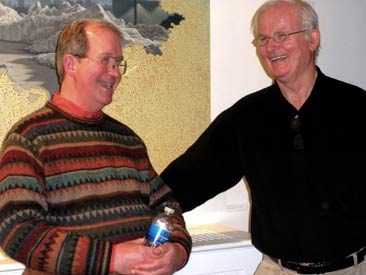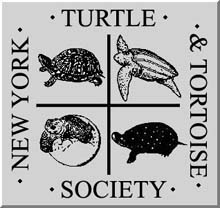 

The New York Turtle and Tortoise Society presents

Seminar 2011

Sunday, April 3, 2011
Check-in 9:30 a.m.; Sessions 10:00 a.m.–5:00 p.m.

The Arsenal, Central Park, 5th Avenue at 64th Street
New York City

 Seminar 2011, the twenty-sixth NYTTS Annual Seminar, was held in the 3rd floor Gallery in the Arsenal (in front of the Central Park Zoo), Central Park, New York City. Seminar 2011, the twenty-sixth NYTTS Annual Seminar, was held in the 3rd floor Gallery in the Arsenal (in front of the Central Park Zoo), Central Park, New York City.
A full-day event, Seminar 2011 featured in-depth presentations by Ward B. Stone, Roger C. Wood, and Peter C.H. Pritchard.

Right: Roger Wood and Peter Pritchard at Seminar 2011
Photo by Barbara Daddario
|
 Scheduled Program
Scheduled Program
 Morning Session
Morning Session
 |
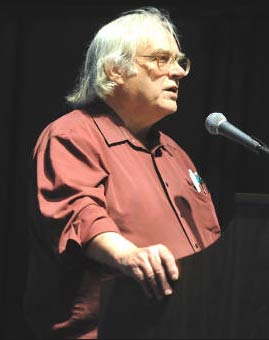

Ward B. Stone, Wildlife Pathologist, New York State Department of Environmental Conservation

Photo: Cindy Schultz/Times Union | |
 |

Ward B. Stone
Wildlife Pathologist (retired)
New York State Department of Environmental Conservation
Adjunct Professor, SUNY Cobleskill and College of Saint Rose

“Turtle Pathology in New York”

As a New York State wildlife pathologist, Dr. Ward Stone was charged with determining cause of death in wild animals. His office was responsible for identifying any envirionmental conditions or contagions that could potentially decimate animal populations, whether naturally occurring or man made. The office further investigated whether those same threats could be affecting humans.

Over the years he has studied the effects of pollution on snapping turtles in New York State, especially in the Hudson River, as well as the impact of the release of exotic turtles into New York waters. He has worked with NYTTS, testing for toxins in softshell turtles collected from Chinatown markets, and he investigatged the spring die-off of snapping turtles in Central Park.

Dr. Stone will discuss pesticides, toxins, and other sources of pollution released into the environment and their impact upon wildlife and humans. While focusing primarily on the work he has done with turtles, he will also touch on the pathology of other wildlife in the state.

Ward Stone graduated with a degree in zoology from Syracuse University and earned a degree in pathology through the U.S. Navy. He was appointed New York State Wildlife Pathologist in 1969. He has been a crusader for wildlife for the majority of his adult life. During his 41 years as New York's wildlife pathologist, he built a statewide reputation as an environmental hero and has been vocal in many controversial issues.

Afternoon Session



Roger Wood at an NYTTS Turtle and Tortoise Show

Photo: Sherry Dohm
|
 Roger C. Wood
Roger C. Wood
Director of Research, The Wetlands Institute, Stone Harbor, New Jersey
Professor of Biology, Stockton State College, Pomona, New Jersey

“Recent Discoveries Shed New Light
on the Evolution of Leatherback Turtles”

A single species of leatherback turtle (Dermochelys coriacea) survives in the world today. Its shell structure is so peculiar that for a long time all turtles were subdivided into two categories: leatherbacks and all others. Leatherbacks are the largest of all existing turtle species, and perhaps even the largest of all living reptiles. They also have the largest geographic distribution of any modern turtle species, being found in nearly all the major oceans of the world. They are one of the deepest-diving of all vertebrates, and somehow manage to subsist happily on a diet consisting almost entirely of jellyfish.

Until recently, paleontologists assumed there was never more than one kind of leatherback turtle at any given time in the past. Most fossil material was routinely referred to a single genus, Psephophorus, all from such far-flung localities as Austria, Belgium, Alabama, New Zealand, and Antarctica. The widespread assumption has always been that Psephophorus evolved directly into Dermochelys. Newly discovered fossil leatherback specimens, however, clearly show that leatherbacks have had a far more interesting and complex evolutionary history,
 |
 |
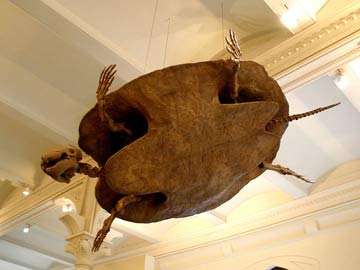

The giant Stupendemys geographicus suspended in the Hall of Vertebrate Origins at the American Museum of Natural History

Photo: Ghedoghedo, Wikepedia Commons |
|
including at times as many as three different contemporaneous lineages.

Dr. Wood will share new information on the evolution of leatherback turtles, based on recently discovered fossils from the East Coast of the United States as well as long-neglected ones from Belgium.

Roger Wood is well known to NYTTS members and the turtle world for his work with diamondback terrapins at the Wetlands Institute in southern New Jersey. Over the years he and student researchers from the Diamondback Terrapin Conservation Project have given numerous reports at our Annual Seminars.

But Roger is first a paleontologist. In 1972 he discovered the world’s largest-known fossil turtle, Stupendemys geographicus, from late Tertiary deposits in Venezuela. This giant “mega-turtle” fossil now “flies” above our heads in the fourth-floor Hall of Vertebrate Origins at the American Museum of Natural History.

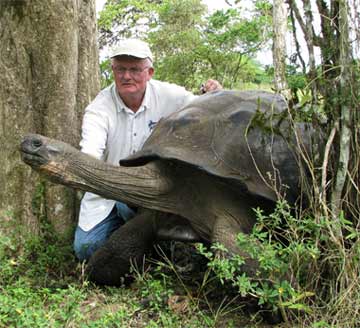

Peter Pritchard with a large adult male Santa Cruz tortoise (Chelonoidis porteri)

Photo: Chelonian Research Institute |
 Peter C. H. Pritchard
Peter C. H. Pritchard
Director, Chelonian Research Institute, Oviedo, Florida

“Galápagos Tortoises: There Are Still Surprises
Latest Developments from the Galápagos”

Galápagos tortoises are among the most familiar and most studied of all the world’s tortoises. But just as the pink iguana showed up as a brand new Galápagos species a year or two ago, there are newly discovered tortoises too: tortoises over 120 years of age still capable of laying good eggs, a whole new species of tortoise on one of the most familiar islands in Galápagos, 2,000 tortoises waiting to be released on Isabela, and over 1,600 tortoises on a volcano that was assumed to have just a few.

Peter Pritchard, one of the world’s foremost experts on turtles and tortoises, is the Director of the Chelonian Research Institute in Oviedo, Florida. The Institute houses one of the largest collections of turtle specimens in the world. He received his Bachelor’s degree from Oxford and his Ph.D. from the University of Florida, where he studied marine turtles with Archie Carr as his major professor. Peter has written eight books about turtles, the most recent a semi-autobiographical work entitled Tales from the Thébaïde. He has studied turtles in many parts of the world, and for several decades has operated a field station in Guyana for protection of nesting marine turtles. Currently, his main activities involve turtles and tortoises in the Galápagos Islands and in eastern Asia, as well as performing a variety of roles in the administration and operation of the Chelonian Research Institute.
|
|
 |
|


